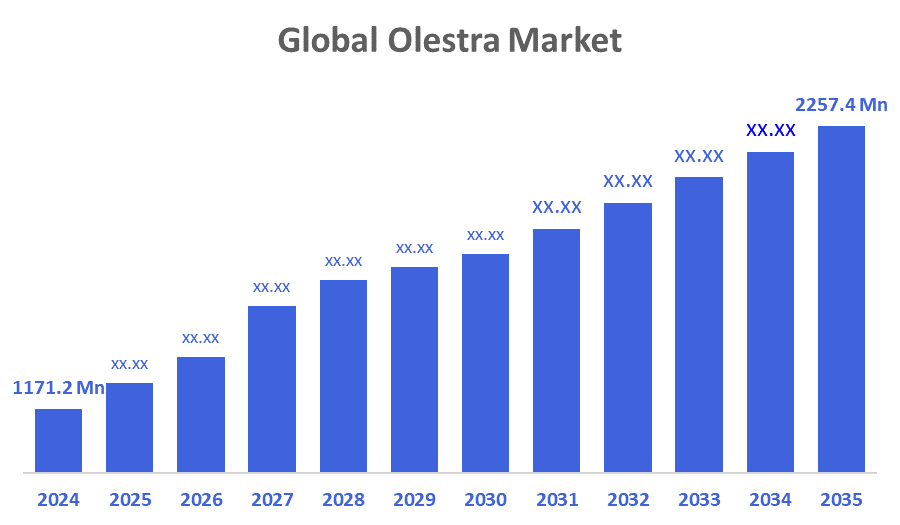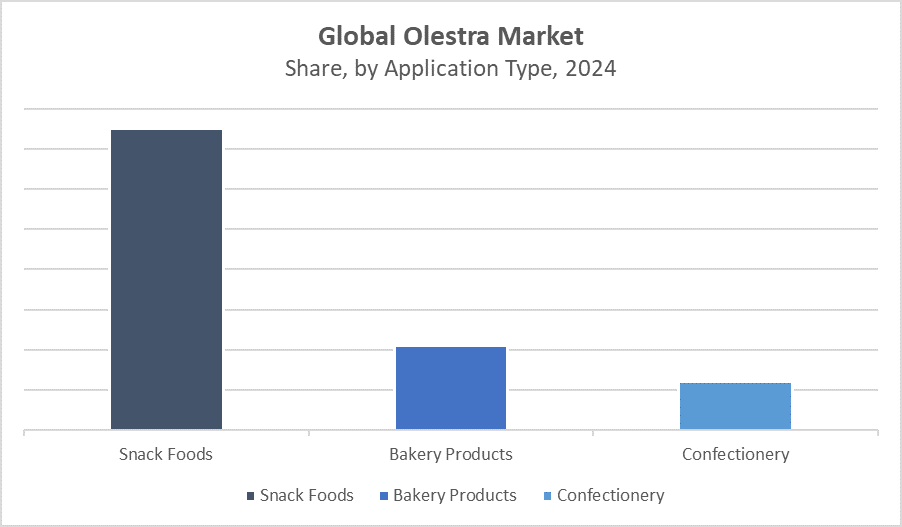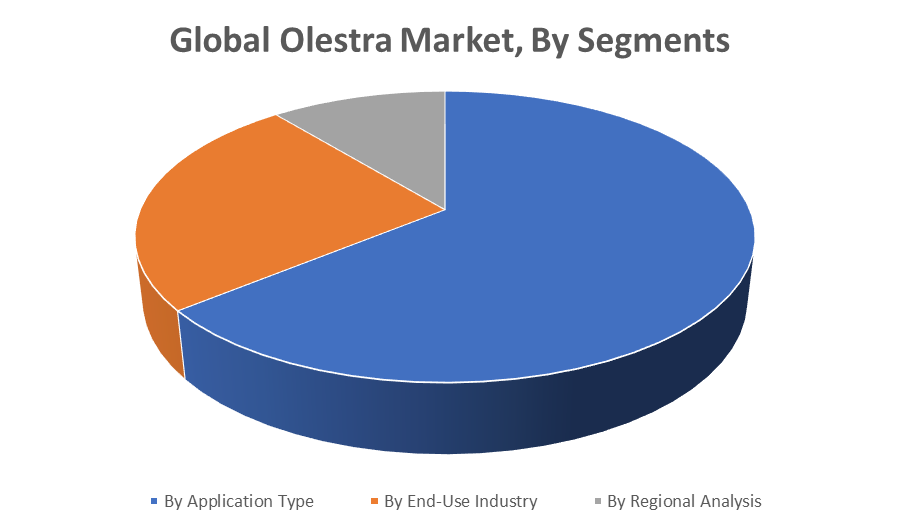Global Olestra Market
Global Olestra Market Size, Share, and COVID-19 Impact Analysis, Impact of Tariff and Trade War Analysis, By Application Type (Snack Foods, Bakery Products, and Confectionery), By End-Use Industry (Retail, Foodservice, and Pharmaceuticals), and By Region (North America, Europe, Asia-Pacific, Latin America, Middle East, and Africa), Analysis and Forecast 2025 - 2035
Report Overview
Table of Contents
Olestra Market Size Summary, Size & Emerging Trends
According to Decisions Advisors, The Global Olestra Market Size is expected to Grow from USD 1171.2 Million in 2024 to USD 2257.4 Million by 2035, at a CAGR of 6.15% during the forecast period 2025-2035. Increasing demand for low-calorie and fat-free food products is a key driving factor for the Olestra market.

Key Market Insights
- North America is expected to account for the largest share in the Olestra market during the forecast period.
- In terms of application type, the snack foods segment dominated in terms of revenue during the forecast period.
- In terms of end-use industry, the retail segment accounted for the largest revenue share in the global Olestra market during the forecast period.
Global Market Forecast and Revenue Outlook
- 2024 Market Size: USD 1171.2 Million
- 2035 Projected Market Size: USD 2257.4 Million
- CAGR (2025-2035): 6.15%
- North America: Largest market in 2024
- Asia Pacific: Fastest growing market
Olestra Market
The Olestra market centers on the production of a fat substitute used primarily in snack foods to reduce calorie content without sacrificing taste or texture. Olestra is a sucrose polyester that is not absorbed by the body, providing a fat-free alternative in processed foods. It is widely used in chips, crackers, and other savory snacks to meet the growing consumer demand for healthier food options. Government regulations and approvals in various countries influence its market dynamics, with ongoing research focusing on minimizing side effects and improving product formulations. The demand for Olestra is driven by increasing health awareness, rising obesity rates, and consumer preference for low-fat diets, positioning it as a valuable ingredient in the food and pharmaceutical industries.
Olestra Market Trends
- Growing consumer preference for fat-free and low-calorie snacks is driving product innovation and demand.
- Research on minimizing gastrointestinal side effects associated with Olestra use is advancing product acceptance.
- Manufacturers are expanding their product portfolio with Olestra-based foods targeting health-conscious consumers.
Olestra Market Dynamics
Driving Factors:
Rising health awareness and demand for low-fat food options
Key growth factors for the Olestra market include increasing consumer health consciousness and the need for calorie-reduced snack foods. The growing prevalence of obesity and cardiovascular diseases globally motivates demand for fat substitutes like Olestra. Regulatory approvals and endorsements for safe use also enhance market growth. Advances in food technology allow manufacturers to improve the sensory qualities of Olestra-containing products, expanding their appeal across demographics.
Restrain Factors:
Consumer concerns about gastrointestinal side effects
Restraining factors in the Olestra market include consumer apprehension due to potential gastrointestinal discomfort, such as cramps and loose stools, which have limited its acceptance in some regions. Regulatory restrictions and labeling requirements add to the market challenges. Additionally, the availability of alternative fat substitutes and natural oils restricts Olestra’s market share. Price sensitivity and taste preferences also impact adoption rates.
Opportunity:
Expansion into emerging markets and new product development
The Olestra market presents opportunities in emerging economies where rising disposable incomes and urbanization increase demand for convenient, low-fat foods. Product innovation to reduce side effects and enhance taste can broaden consumer acceptance. Collaborations with pharmaceutical companies for specialized dietary applications open new avenues. Additionally, growing demand for fat substitutes in bakery and confectionery sectors offers further growth potential.
Challenges:
Regulatory hurdles and public perception
Challenges in the Olestra market include navigating strict regulatory approvals and negative public perception due to health concerns. Ensuring transparent labeling and educating consumers about safety are critical to overcoming resistance. Competitive pressure from natural fat substitutes and clean-label trends pose additional challenges. Maintaining product quality while managing costs is essential to sustain market growth.
Global Olestra Market Ecosystem Analysis
The global Olestra market ecosystem includes raw material suppliers (mainly sucrose and fatty acid producers), manufacturers such as Procter & Gamble (the original developer), and end-users in food processing and pharmaceutical sectors. Regulatory bodies play a key role in market approvals and compliance. The ecosystem’s growth depends on innovation in product formulation, regulatory alignment, and expanding consumer awareness, driving the market expansion worldwide.
Global Olestra Market, By Application Type
The snack foods segment dominated the Olestra market in terms of revenue during the forecast period, accounting for approximately 55% of the total market share. This dominance is due to Olestra’s unique ability to provide fat-free alternatives in popular snack items such as potato chips, crackers, and pretzels without compromising taste or texture. Consumers looking for healthier snack options prefer products containing Olestra because they can enjoy the same sensory experience as regular snacks but with significantly reduced calories and fat content. This segment’s strong consumer acceptance and widespread availability in retail outlets contribute heavily to its leading position in the market.

The bakery products segment holds a significant share, estimated at around 25% of the global Olestra market revenue. Olestra is increasingly used in bakery items like cookies, pastries, and cakes to reduce fat content while maintaining desirable texture and mouthfeel. The demand for low-fat bakery products among health-conscious consumers and those managing dietary restrictions supports steady growth in this segment.
Global Olestra Market, By End-Use Industry
The retail segment accounted for the largest revenue share in the global Olestra market during the forecast period, capturing approximately 60% of the total market revenue. This segment includes supermarkets, hypermarkets, convenience stores, and online retail platforms that offer Olestra-containing products directly to consumers. The dominance of this segment is driven by increasing consumer awareness about healthy eating and demand for fat-free or low-fat snack alternatives available for home consumption. Retail channels provide wide product variety and accessibility, making them the primary sales avenue for Olestra-based snacks and food products.
The foodservice segment holds a significant share of around 25% in the Olestra market. This sector includes restaurants, cafeterias, fast-food chains, and catering services that incorporate Olestra-based ingredients in their menu items to cater to health-conscious customers. The growing emphasis on offering healthier dining options and the rise in demand for fat-free foods in foodservice establishments support steady growth in this segment.
North America is expected to account for the largest share of the Olestra market during the forecast period, holding approximately 40% of the global market revenue.
This regional dominance is driven by several factors, including high consumer awareness regarding health and nutrition, widespread regulatory approvals supporting the use of Olestra in food products, and the presence of major multinational food manufacturers headquartered in the region. Additionally, North America’s strong focus on health and wellness trends continues to boost demand for fat-free and low-fat snack alternatives, further fueling the adoption of Olestra-containing products across retail and foodservice channels.
India is emerging as a significant growth market for Olestra, with a projected compound annual growth rate (CAGR) of approximately 9% during the forecast period.
This growth is fueled by rapid urbanization, increasing disposable incomes, and a growing preference among Indian consumers for healthier snack options. The expansion of modern retail infrastructure, alongside the growth of the food processing industry, provides a supportive environment for market growth. Rising awareness about diet-related health issues and changing lifestyle habits also contribute to the increasing demand for Olestra-based products in the Indian market.
Europe is anticipated to register a steady CAGR in the Olestra market during the forecast period,
Supported by clearer regulatory frameworks and rising consumer demand for low-fat and healthier food options. Key countries such as Germany, the United Kingdom, and France are major contributors to the region’s market expansion. European consumers’ growing health consciousness, coupled with increased availability of Olestra-containing products, drives consistent growth. Additionally, ongoing innovations in product formulations to meet diverse dietary needs support the market’s positive outlook in this region.
WORLDWIDE TOP KEY PLAYERS IN THE OLESTRA MARKET INCLUDE
- Procter & Gamble
- ADM (Archer Daniels Midland)
- Cargill, Incorporated
- Ingredion Incorporated
- Tate & Lyle PLC
- DuPont Nutrition & Health
- Associated British Foods
- Roquette Frères
- Others
Product Launches in Olestra Market
- In March 2024, Procter & Gamble introduced a new line of fat-free potato chips in North America. These chips feature an improved Olestra formulation designed to enhance taste and texture. The launch targets the rising consumer demand for healthier, low-fat snack alternatives. This innovation strengthens Procter & Gamble’s position in the health-conscious snack market.
Market Segment
This study forecasts revenue at global, regional, and country levels from 2020 to 2035. Decisions Advisors has segmented the Olestra market based on the below-mentioned segments:

Global Olestra Market, By Application Type
- Snack Foods
- Bakery Products
- Confectionery
Global Olestra Market, By End-Use Industry
- Retail
- Foodservice
- Pharmaceuticals
Global Olestra Market, By Regional Analysis
- North America
- US
- Canada
- Mexico
- Europe
- Germany
- UK
- France
- Italy
- Spain
- Russia
- Rest of Europe
- Asia Pacific
- China
- Japan
- India
- South Korea
- Australia
- Rest of Asia Pacific
- South America
- Brazil
- Argentina
- Rest of South America
- Middle East & Africa
- UAE
- Saudi Arabia
- Qatar
- South Africa
- Rest of the Middle East & Africa
Check Licence
Choose the plan that fits you best: Single User, Multi-User, or Enterprise solutions tailored for your needs.
We Have You Covered
- 24/7 Analyst Support
- Clients Across the Globe
- Tailored Insights
- Technology Tracking
- Competitive Intelligence
- Custom Research
- Syndicated Market Studies
- Market Overview
- Market Segmentation
- Growth Drivers
- Market Opportunities
- Regulatory Insights
- Innovation & Sustainability
Report Details
| Pages | 156 |
| Delivery | PDF & Excel via Email |
| Language | English |
| Release | Sep 2025 |
| Access | Download from this page |
